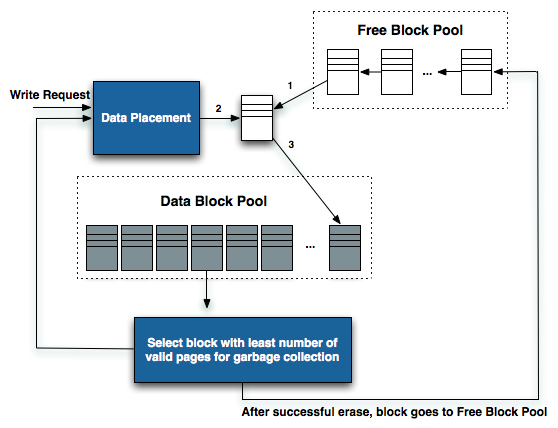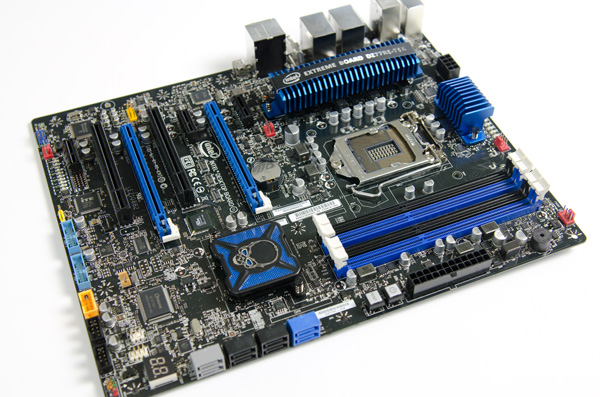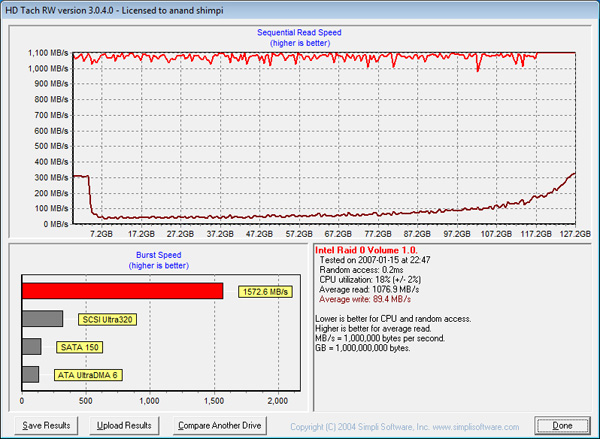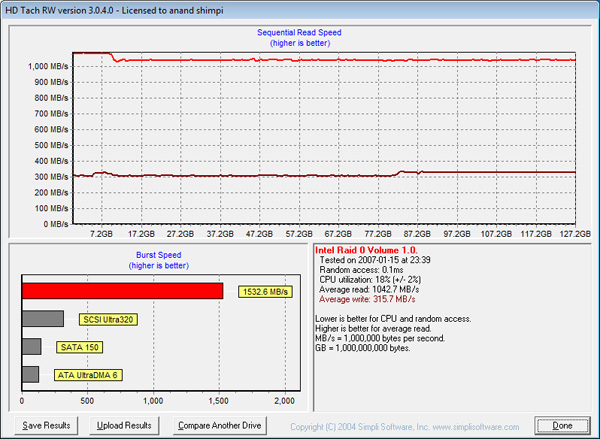Intel Brings TRIM to RAID-0 SSD Arrays on 7-Series Motherboards, We Test It
by Anand Lal Shimpi on August 16, 2012 12:04 AM ESTIn an unusually terse statement, Intel officially confirmed that the ATA TRIM command now passes through to RAID-0 SSD arrays on some systems running Intel's RST (Rapid Storage Technology ) RAID driver version 11.0 and newer. The feature is limited to Intel 7 series chipsets with RST RAID support and currently only works on Windows 7 OSes, although Windows 8 support is forthcoming.
As soon as I got confirmation from Intel, I fired up a testbed to confirm the claim. Before I get to the results, let's have a quick recap of what all of this means.
Why does TRIM Matter?
The building block of today's SSDs that we love so much is 2-bit-per-cell MLC NAND Flash. The reason that not all SSDs are created equal is because of two important factors:
1) Each NAND cell has a finite lifespan (determined by the number of program and erase cycles), and
2) Although you can write to individual NAND pages, you can only erase large groups of pages (called blocks)
These two factors go hand in hand. If you only use 10% of your drive's capacity, neither factor is much of an issue. But if you're like most users and run your drive near capacity, difficulties can arise.
Your SSD controller has no knowledge of what pages contain valid vs. invalid (aka deleted) data. As a result, until your SSD is told to overwrite a particular address, it has to keep all data on the drive. This means that your SSD is eternally running out of free space. Thankfully all SSDs have some percentage of spare area set aside to ensure they never actually run out of free space before the end user occupies all available blocks, but how aggressively they use this spare area determines a lot.
Aggressive block recycling keeps performance high, at the expense of NAND endurance. Conservative block recycling preserves NAND lifespan, at the expense of performance. It's a delicate balance that a good SSD controller must achieve, and there are many tricks that can be employed to make things easier (e.g. idle time garbage collection). One way to make things easier on the controller is the use of the ATA TRIM command.

In a supported OS, with supported storage drivers and on an SSD with firmware support, the ATA TRIM command is passed from the host to the SSD whenever specific logical block addresses (LBAs) are no longer needed. In the case of Windows 7, a TRIM command is sent whenever a drive is formatted (all LBAs are TRIMed), whenever the recycle bin is emptied or whenever a file is shift + deleted (the LBAs occupied by that file are TRIMed).
The SSD doesn't have to take immediate action upon receiving the TRIM command for specific LBAs, but many do. By knowing what pages and blocks no longer contain valid data, the SSD controller can stop worrying about preserving that data and instead mark those blocks for garbage collection or recycling. This increases the effective free space from the controller's perspective, and caps a drive's performance degradation to the amount of space that's actively used vs. a continuing downward spiral until the worst case steady state is reached.
TRIM was pretty simple to implement on a single drive. These days all modern SSDs support it. It's only if you have one of the early Intel X25-M G1s that you're stuck without TRIM. Drives that preceded Intel's X25-M are also TRIMless. Nearly all subsequent drives we recommended either had TRIM support enabled through a firmware update or had it from the start.
Enabling TRIM on a RAID array required more effort, but only on the part of the storage driver. The SSD's firmware and OS remain unchanged. Intel eventually added TRIM support in its RAID drivers for RAID-1 (mirrored) arrays, but RAID-0 arrays were a different story entirely. There's a danger in getting rid of data in a RAID-0 array, if a page or a block gets TRIMed on one drive that's actually necessary, the entire array can be shot. There was talk of Intel enabling TRIM support on RAID-0 arrays as early as 2009, but given the cost of SSDs back then not many users were buying multiple to throw in an array.
The cost of SSDs has dropped considerably in the past 4 years. The SSD market is far more mature than it used to be. Intel isn't as burdened with the responsibility of bringing a brand new controller and storage technology to market. With some spare time on its hands, Intel finally delivered a build of its RAID drivers that will pass the ATA TRIM command to RAID-0 arrays.
The Requirements
The requirements for RAID-0 TRIM support are as follows:
A 7-series motherboard (6-series chipsets are unfortunately not supported).
Intel's Rapid Storage Technology (RST) for RAID driver version 11.0 or greater (11.2 is the current release)
Windows 7 (Windows 8 support is forthcoming)
The lack of support for 6-series chipsets sounds a lot like a forced feature upgrade. Internally Intel likely justifies it by not wanting to validate on older hardware, but I don't see a reason why TRIM on RAID-0 wouldn't work on 6-series chipsets.
I am not sure if TRIM will work on RAID-10 arrays. I'm going to run some tests shortly to try and confirm. Update: I don't believe it works on RAID-10 arrays. I'm still running tests to confirm but so far it looks like the answer is no.
Testing TRIM on RAID-0
I set up a Z77 testbed using Intel's DZ77GA-70K motherboard. I configured the board for RAID operation and installed Windows 7 SP1 to a single boot SSD. I then took two Samsung SSD 830s and created a 128GB RAID-0 array (64GB + 64GB). I picked the 830 because it benefits tremendously from TRIM, when full and tortured with random writes the 830's performance tanks. I secure erased both drives before creating the RAID array to ensure I started with a clean slate.
The 64GB Samsung SSD 830 is good for almost 500MB/s in sequential reads and under 160MB/s sequential writes. Two of them in RAID-0 should be able to deliver over 1GB/s of sequential read performance and over 300MB/s in sequential writes. A quick pass of HDTach confirms just that:
Take a moment to marvel at just how much performance you can get out of two $90 SSDs.
For the control run I used Intel's 10.6 RST drivers (10.6.0.1022). I filled the array with sequential data, then randomly wrote 4KB files over the entire array at a queue depth of 32 for 30 minutes straight. I formatted the array (thus TRIMing all LBAs) and ran an HD Tach pass to see if performance recovered. Remember if the controller was told that all of its data was invalid, a sequential write pass would run at full speed since all data would be thrown away as it was being overwritten. Otherwise, the controller would try to preserve its drive full of garbage data as long as possible.
The 10.6 RST drivers don't pass TRIM through to RAID-0 arrays, and the results show us just that:
That's no surprise, but what happens if we do the same test using Intel's 11.2 RST drivers?
Here's what the pass looks like after the same fill, torture, TRIM, HD Tach routine with the 11.2 drivers installed:
Perfect. TRIM works as promised. Users running SSDs in RAID-0 on 7-series motherboards can enjoy the same performance maintaining features that single-drive users have.
Bringing TRIM support to RAID-0 arrays provides users with a way of enjoying next-gen SSD performance sooner rather than later, without giving up an important feature. Pretty much all high-end SSDs are capped to 6Gbps limits when it comes to sequential IO. Modern SATA controllers deliver 6Gbps per port, allowing you to break through the 6Gbps limit by aggregating drives in RAID.
The only negative here is that Intel is only offering support on 7-series chipsets and not on previous hardware. That's great news for anyone who just moved to Ivy Bridge and has a RAID-0 array of SSDs, but not so great for everyone else. A lot of folks supported Intel over the past couple of years and Intel has had some amazing quarters as a result - I feel like the support should be rewarded. While I understand Intel's desire to limit its validation costs, I don't have to be happy about it.
For more information on how SSDs work, check out our last major article on the topic.














41 Comments
View All Comments
tspacie - Thursday, August 16, 2012 - link
So, there are a bunch of requirements and hoops to get TRIM on Intel RAID, what if you just use the windows disk manager to create a raid 0 stripe? Does that also pass through TRIM commands?Farfle - Sunday, August 19, 2012 - link
I'd like this confirmed as well. There's no hard evidence on the web I've found that neither confirms nor denies trim support on striped or spanned volumes using dynamic disks in Windows. A lot of people think its enabled, providing the driver used is in AHCI mode, but no one has provided a benchmark like how Anand did with this article to prove one way or the other.A confirmation on this would be extremely helpful, as dynamic disks are incredibly easy to use and are hardware agnostic. Their only caveats are not being able to install OS on them, and them being native to windows only.
surgex - Saturday, September 29, 2012 - link
Yes -- TRIM does work with Dynamic Disks.The problem is you can't BOOT from a Dynamic Disk stripe (RAID 0) -- you can only boot from a Mirror (RAID 1).
And also -- even setting up a Bootable Dynamic Disk RAID1 is a PITFA -- you have to first install windows, then convert the disk to dynamic, then add a mirror, then reboot and hope it works. Why don't they just let you set this up from the installer!?
Also, in my experience -- Dynamic Disk mirroring is rather flaky.
The performance is OK -- I find RST to have better READ performance (random and sequential) in general with two 830s in an SSD RAID1 compared to Dynamic Disks-- but if you pull drives during I/O, sometimes Windows just hangs -- other times it works. With the Intel RST I can pull drives all day long and my system stays working just fine (aka there's ACTUAL redundancy here).
kavanoz - Thursday, August 16, 2012 - link
Anand,You wrote it like 7 series motherboard requirement was a software limitation rather than hardware. If this is the case, I am sure someone will modify the drivers and allow it to work on 6 series motherboards.
What do you think?
Ototin - Thursday, August 16, 2012 - link
...and for that matter, what about those of us still on 5 series chipsets? My X58 setup has hung on tenaciously over the past few years while I wait for Haswell...would be a shame to only be able to run my one 830 (over SATA2, even) for the next year and miss out on the cheap performance boost a RAID 0 setup would offer.SlyNine - Friday, August 17, 2012 - link
Unless you are running your drive to max capacity its not really needed. If you want to restore performance just do one huge sequential write.JonnyDough - Friday, November 30, 2012 - link
It's been done! :) Not by me...but on another article it's working!iwodo - Thursday, August 16, 2012 - link
Do Software Raid improves Random Read Write?All of a sudden Raid SSD becomes so attractive everybody should be using it instead of buying 128GB SSD!
Kristian Vättö - Thursday, August 16, 2012 - link
Small random reads at queue depth of 1 are not improved, but everything else is.surgex - Saturday, September 29, 2012 - link
Correct -- this is because for the most part -- the SSD controllers are actually more efficient at small random reads and writes than actual RAID controllers (even a $1000 LSI MegaRAID card) -- be it hardware OR software.